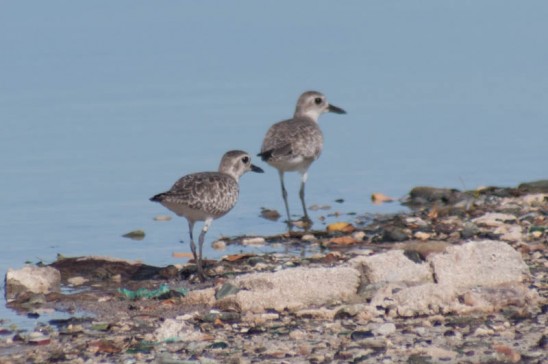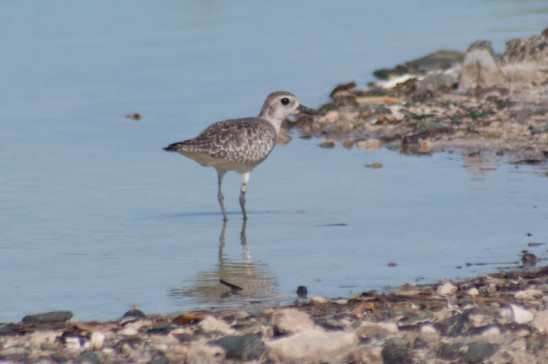November 19th, 2011 by Marc AuMarc
Mont Fortune is not much of a mountain. In fact, it is only 67 meters tall. However, its location on a small peninsula jutting out into the Simpson Bay Lagoon gives it some great views of the island, particularly the lagoon.
I started in Bellevue, where I found some very large guppies in a small stream behind the industrial area. I headed off the main road near the Sucrerie Saint Jean, and walked across the wetland area and the improbable rugby field in the middle of nowhere. The wetland area is interesting, with a variety of succulents and salt-tolerant grasses, but also the occasional cactus.
Passing a few cow skeletons, I went through fields and forest at the edge of the lagoon, probably a good place to see birds, and I saw a kingfisher and a couple yellow-crowned night herons. Mont Fortune itself was an easy climb and offered great vistas. The top is flat and covered in goat poo. I headed back to the road near the border monument. Aside from a couple fences that get in the way, it’s an easy, enjoyable walk.
Posted in Explorations, Les Fruits sur la Terre
Comment on this post.
November 19th, 2011 by Marc AuMarc
On a recent walk around Grand Case Bay, there were quite a few interesting things to see. The mangrove tree on the cemetery pond that is home to dozens of egrets during nesting season was still completely bare, and home to one iguana. On the same pond, although the egrets are gone, the common gallinules were present in large numbers, including juveniles of two different ages. A juvenile peregrine falcon was cruising around Molly Smith Point, an unusual sighting for the island.
Posted in Explorations, Les Fruits sur la Terre
Comment on this post.
November 18th, 2011 by Marc AuMarc
Our last dive, just off Great Dog Island was very fun. The site consists of a large area of coral gardens and the wingless wreck of an airplane a short distance away. Pre-dive, we did reconnaissance via snorkel and dinghy to locate the wreck itself, and did our diving from the dinghy. The current was strong, particularly in the open, sandy area where the wreck is located. Luckily, the wreck itself provided shelter from the current once we arrived there.
For some reason, I find diving plane wrecks to be particularly enjoyable, and this was no exception. Approaching the wreck, we were greeted by some of the residents, several huge horse-eye jacks. The remains of the plane were covered in sponges and other growth, with a variety of tropical fish in and around the wreck. We spent most of the dive there, exploring and taking photographs, although we did make a quick excursion to the nearby reef. When it came time to go, we flew along with the current back to the dinghy’s anchor line.
Posted in Diving, On Expedition
Comment on this post.
November 18th, 2011 by Marc AuMarc
The dive site Black Forest, just off the western end of Peter Island, consists of a shallow reef leading to a wall about thirty-five feet tall. The site is named after the shallow water black coral that can be seen along the wall. At one end, we were able to see a field of garden eels, rising out of their burrows like a strange kind of grass that disappears when you approach it. There were also many beautiful clusters of blue bell tunicates, which look like very simple animals, but are in fact primitive chordates, that apparently have a tadpole-like appearance as larvae.
Posted in Diving, On Expedition
Comment on this post.
November 16th, 2011 by Marc AuMarc
Norman Island is an uninhabited island south of Tortola, and undoubtedly the best Extreme Shallow Snorkeling site we’ve been to in ages. A protected bay much beloved by pirates, it is also full of fish and the pelicans and brown boobies that love to eat them.
Our adventure began when we came onshore by dinghy to get the scuba tanks filled. Intending to take a quick snorkel while the tanks were filling, we discovered a wonderland full of huge schools of bait fish, pelicans diving almost on top of us and gigantic tarpon patrolling the two piers. Stingrays were abundant, often cruising in a foot of water near the shore, and a wide variety of reef fish were there, including beauties like the scrawled filefish. Needless to say, the tanks were filled long before we got back out of the water, and we immediately headed back to the boat to grab our cameras.
Back in the shallows with our photo and video gear, we explored the whole area again and probably would have never left if we didn’t have to. We actually didn’t even explore the nearby underwater caves. Although we didn’t find pirate treasure, we found a snorkeling paradise that must be revisited. Photos don’t do it justice, but here are a few. Did I mention the tarpon were huge? People arriving at the dinghy dock kept thinking they were sharks.
Posted in Extreme Shallow Snorkeling, On Expedition
Comment on this post.
November 16th, 2011 by Marc AuMarc
The Indians are a series of rocks jutting out of the water near Norman Island. A long time ago, someone thought they looked like tee-pees, hence the name. For us, it was another opportunity to go diving, so we moored up the boat and Stephen, Olivia, Madam J and I jumped in to take a look.
The dive involved circumnavigating three of the four rocks, passing between the last two. The underwater landscape was lovely, rich with corals and sponges. After poking around a bit, we located a small cave that was full of glassy sweepers. Just outside the cave we saw an Atlantic spadefish, a little bit unusual to see, but even stranger to see alone. I also caught a glimpse of a very small reef shark.
Posted in Diving, On Expedition
Comment on this post.
November 16th, 2011 by Marc AuMarc
Guana Island is a small island just north of Tortola, which allegedly has the greatest terrestrial biodiversity of any island its size in the Caribbean and possibly the world. We didn’t set foot on land, but we did get a couple chances to snorkel. On our first excursion we discovered some successfully transplanted elkhorn corals near the beach. As it turns out, these were done by a team including Graham Forrester, who we had the pleasure of meeting in Saba last year. You can read more about their study in this pdf. The corals we saw were doing very well and were quite large for three or four years of growth.
The next day we explored other parts of the bay and found a wide variety of sea life, including a greedy octopus who seemed to be trying to eat several mollusks at once. Stephen spotted a large southern stingray and I found a nurse shark and a snapper that was practically the size of a shark. Madam J, unfortunately, found a lionfish. The previous evening we’d seen lots of small fish jumping out of the water, and our observations while snorkeling confirmed that there were quite a few schools of small jacks who were probably responsible, attacking the baitfish and getting them to jump.
Posted in Extreme Shallow Snorkeling, On Expedition
Comment on this post.
November 15th, 2011 by Marc AuMarc
Located just off the shore of Great Dog Island, a dive site called The Chimney was our first dive of the trip. The site includes a series of canyons and an allegedly awesome arch that we didn’t actually see due to the current. I was having some strobe issues with my underwater camera rig, so a bunch of the photos from this site are presented in black and white rather than overwhelming blue. Highlights included lovely canyon walls, schools of creole wrasses and some interesting underwater topography. It was exciting to dive on our own on an unfamiliar site and a taste of great things to come. As chance would have it, dives at Great Dog Island bookended our trip. Due to the swell, we returned to the south side of the island on our last day to dive at Coral Gardens.
Posted in Diving, On Expedition
Comment on this post.
November 15th, 2011 by Marc AuMarc
While investigating the recent fish apocalypse at Salines d’Orient, I happened upon another banded bird, this time a black-bellied plover (Pluvialis squatarola) that had what seemed to be a single, unnumbered metallic band on its upper-right leg. It had two unbanded companions and I have reported the sightings and hopefully will learn when and where it was originally banded.
Below are a couple photos of the banded bird. If you see any banded birds, you can report them to bandedbirds.org and/or reportband.gov.


Posted in Les Fruits sur la Terre, Pour les Sciences
Comment on this post.
November 15th, 2011 by Marc AuMarc
The coverage of our recent expedition to the British Virgin Islands begins at the site of our arrival, The Baths in Virgin Gorda. This well-loved area is essentially a beach covered in gigantic boulders, creating a variety of grottoes and nooks both above and below the water line.
We explored both on foot and on snorkel, and there were plenty of extremely shallow areas full of life. Fish were abundant and tiny orange anemones were often clustered in shady areas and crevices. Madam J found a gorgeous underwater arch we were able to swim through, and nearby I discovered a small cave with an underwater entrance leading to an air-filled dome. Judging by the number of names and initials carved into the ceiling, I was not the first to discover it.
Posted in Explorations, Extreme Shallow Snorkeling, On Expedition
Comment on this post.
















































































































































































